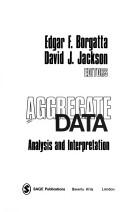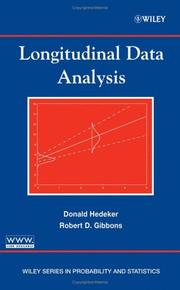| Listing 1 - 10 of 12 | << page >> |
Sort by
|
Book
ISBN: 9781118831984 Year: 2014 Publisher: Somerset : John Wiley & Sons, Incorporated,
Abstract | Keywords | Export | Availability | Bookmark
 Loading...
Loading...Choose an application
- Reference Manager
- EndNote
- RefWorks (Direct export to RefWorks)
An introduction to the mathematical theory and financial models developed and used on Wall Street Providing both a theoretical and practical approach to the underlying mathematical theory behind financial models, Measure, Probability, and Mathematical Finance: A Problem-Oriented Approach presents important concepts and results in measure theory, probability theory, stochastic processes, and stochastic calculus. Measure theory is indispensable to the rigorous development of probability theory and is also necessary to properly address martingale measures, the change of numeraire theory, and LIBOR market models. In addition, probability theory is presented to facilitate the development of stochastic processes, including martingales and Brownian motions, while stochastic processes and stochastic calculus are discussed to model asset prices and develop derivative pricing models. The authors promote a problem-solving approach when applying mathematics in real-world situations, and readers are encouraged to address theorems and problems with mathematical rigor. In addition, Measure, Probability, and Mathematical Finance features: A comprehensive list of concepts and theorems from measure theory, probability theory, stochastic processes, and stochastic calculus Over 500 problems with hints and select solutions to reinforce basic concepts and important theorems Classic derivative pricing models in mathematical finance that have been developed and published since the seminal work of Black and Scholes Measure, Probability, and Mathematical Finance: A Problem-Oriented Approach is an ideal textbook for introductory quantitative courses in business, economics, and mathematical finance at the upper-undergraduate and graduate levels. The book is also a useful reference for readers who need to build their mathematical skills in order to better understand the mathematical theory of derivative pricing models.

ISBN: 0803912943 0803912951 9780803912946 9780803912953 Year: 1979 Publisher: Beverly Hills, Calif. Sage
Abstract | Keywords | Export | Availability | Bookmark
 Loading...
Loading...Choose an application
- Reference Manager
- EndNote
- RefWorks (Direct export to RefWorks)
Book
ISBN: 9066950064 9789066950061 Year: 1985 Volume: 4 Publisher: Leiden DSWO press
Abstract | Keywords | Export | Availability | Bookmark
 Loading...
Loading...Choose an application
- Reference Manager
- EndNote
- RefWorks (Direct export to RefWorks)
Social sciences --- Research --- Statistical methods --- Longitudinal studies --- -Social sciences --- -Behavioral sciences --- Human sciences --- Sciences, Social --- Social science --- Social studies --- Civilization --- -Statistical methods --- -Research --- Behavioral sciences --- Research&delete& --- Social sciences - Research - Statistical methods --- Social sciences - Longitudinal studies
Book
ISBN: 0395307902 9780395307908 Year: 1979 Publisher: Boston Houghton Mifflin
Abstract | Keywords | Export | Availability | Bookmark
 Loading...
Loading...Choose an application
- Reference Manager
- EndNote
- RefWorks (Direct export to RefWorks)
Quantitative methods in social research --- Methods in social research (general) --- Mathematical statistics --- Social sciences --- Sciences sociales --- Research --- Fieldwork --- Recherche --- Recherche sur le terrain --- Statistical methods --- #SBIB:303H510 --- #SBIB:303H520 --- Methoden sociale wetenschappen: statistische technieken, algemeen --- Methoden sociale wetenschappen: techniek van de analyse, algemeen --- Social sciences - Research - Statistical methods --- Social sciences - Research --- Social sciences - Fieldwork
Book
ISBN: 9780805862379 9780805862386 0805862374 0805862382 9780203867266 9781135269616 9781135269654 9781135269661 Year: 2009 Publisher: New York Routledge
Abstract | Keywords | Export | Availability | Bookmark
 Loading...
Loading...Choose an application
- Reference Manager
- EndNote
- RefWorks (Direct export to RefWorks)
Quantitative methods in social research --- Organization --- Social sciences --- #SBIB:316.334.2A15 --- #SBIB:303H12 --- Organisation --- Management --- Research --- Methodology. --- Statistical methods. --- Arbeidssociologische onderzoeksmethoden en technieken --- Methoden en technieken: sociale wetenschappen --- Methodology --- Statistical methods --- Behavioral sciences --- Human sciences --- Sciences, Social --- Social science --- Social studies --- Civilization --- Research&delete& --- Organization - Research - Methodology --- Organization - Research - Statistical methods --- Social sciences - Statistical methods --- Social sciences - Research - Statistical methods
Book
ISBN: 9780415838986 0415838983 9780415838993 0415838991 9780203775851 9781135039417 9781135039424 0203867262 Year: 2015 Publisher: New York Routledge
Abstract | Keywords | Export | Availability | Bookmark
 Loading...
Loading...Choose an application
- Reference Manager
- EndNote
- RefWorks (Direct export to RefWorks)
This book provides an up-to-date review of commonly undertaken methodological and statistical practices that are based partially in sound scientific rationale and partially in unfounded lore. Some examples of these “methodological urban legends” are characterized by manuscript critiques such as: (a) “your self-report measures suffer from common method bias”; (b) “your item-to-subject ratios are too low”; (c) “you can’t generalize these findings to the real world”; or (d) “your effect sizes are too low.What do these critiques mean, and what is their historical basis? More Statistical and Methodological Myths and Urban Legends catalogs several of these quirky practices and outlines proper research techniques. Topics covered include sample size requirements, missing data bias in correlation matrices, negative wording in survey research, and much more
Organization --- Social sciences --- #SBIB:316.334.2A15 --- #SBIB:303H12 --- Organisation --- Management --- Research --- Methodology. --- Statistical methods. --- Arbeidssociologische onderzoeksmethoden en technieken --- Methoden en technieken: sociale wetenschappen --- Methodology --- Statistical methods --- Behavioral sciences --- Human sciences --- Sciences, Social --- Social science --- Social studies --- Civilization --- Research&delete& --- Organization - Research - Methodology --- Organization - Research - Statistical methods --- Social sciences - Statistical methods --- Social sciences - Research - Statistical methods
Book
ISBN: 9781439813263 1439813264 9780429191602 Year: 2011 Publisher: Boca Raton CRC Press
Abstract | Keywords | Export | Availability | Bookmark
 Loading...
Loading...Choose an application
- Reference Manager
- EndNote
- RefWorks (Direct export to RefWorks)
Social sciences --- Multivariate analysis --- Research --- Mathematical models --- Statistical methods --- Data processing --- Behavioral sciences --- Human sciences --- Sciences, Social --- Social science --- Social studies --- Civilization --- Multivariate distributions --- Multivariate statistical analysis --- Statistical analysis, Multivariate --- Analysis of variance --- Mathematical statistics --- Matrices --- Research&delete& --- Social sciences - Research - Mathematical models --- Social sciences - Research - Statistical methods --- Social sciences - Research - Data processing
Book
ISBN: 144628266X 9781446282663 1473957893 1473959055 1473959047 1786840847 Year: 2016 Publisher: Los Angeles: SAGE Reference,
Abstract | Keywords | Export | Availability | Bookmark
 Loading...
Loading...Choose an application
- Reference Manager
- EndNote
- RefWorks (Direct export to RefWorks)
Survey Methodology is becoming a more structured field of research, deserving of more and more academic attention. The SAGE Handbook of Survey Methodology explores both the increasingly scientific endeavour of surveys and their growing complexity, as different data collection modes and information sources are combined. The handbook takes a global approach, with a team of international experts looking at local and national specificities, as well as problems of cross-national, comparative survey research. The chapters are organized into seven major sections, each of which represents a stage in the survey life-cycle: Surveys and Societies Planning a Survey Measurement Sampling Data Collection Preparing Data for Use Assessing and Improving Data Quality The SAGE Handbook of Survey Methodology is a landmark and essential tool for any scholar within the social sciences.
Surveys --- Social surveys --- Social sciences --- #SBIB:303H30 --- #SBIB:303H32 --- Government surveys --- Mathematical geography --- Methodology. --- Statistical methods. --- Kwalitatieve methoden: algemeen --- Waarneming en participerende waarneming, gecontroleerde observatie, groepsdiscussie (vragenlijsten, interviews, experimenten) --- Methodology --- Research --- Statistical methods --- Umfrage. --- Empirische Sozialforschung. --- Methodologie. --- Methodenlehre --- Methodik --- Wissenschaftstheorie --- Logik --- Methode --- Empirische Soziologie --- Sozialforschung --- Soziologie --- Bevölkerungsumfrage --- Repräsentativumfrage --- Meinungsbefragung --- Meinungsumfrage --- Volksbefragung --- Befragung --- Umfragen --- Demoskopie --- Civilization --- Behavioral sciences --- Human sciences --- Sciences, Social --- Social science --- Social studies --- Community surveys --- Surveys, Social --- Surveys - Methodology --- Social surveys - Methodology --- Social sciences - Research - Statistical methods
Book
ISBN: 9781506378053 1506378056 1071814257 150637803X 1506378048 1506378064 Year: 2019 Volume: 178 Publisher: Los Angeles, CA : SAGE Publications, Inc.,
Abstract | Keywords | Export | Availability | Bookmark
 Loading...
Loading...Choose an application
- Reference Manager
- EndNote
- RefWorks (Direct export to RefWorks)
A concise, introductory text, Propensity Score Methods and Applications describes propensity score methods (PSM) and how they are used to balance the distributions of observed covariates between treatment conditions as a means to reduce selection bias. This new QASS title specifically focuses on the procedures of implementing PSM for research in social sciences, instead of merely demonstrating the effectiveness of the method. Using succinct and approachable language to introduce the basic concepts of PSM, authors Haiyan Bai and M. H. Clark present basic concepts, assumptions, procedures, available software packages, and step-by-step examples for implementing PSM using real-world data, with exercises at the end of each chapter allowing readers to replicate examples on their own.
Social sciences --- Analysis of variance --- Research --- Statistical methods --- ANOVA (Analysis of variance) --- Variance analysis --- Mathematical statistics --- Experimental design --- Behavioral sciences --- Human sciences --- Sciences, Social --- Social science --- Social studies --- Civilization --- Research&delete& --- #SBIB:303H10 --- #SBIB:303H520 --- Methoden en technieken: algemene handboeken en reeksen --- Methoden sociale wetenschappen: techniek van de analyse, algemeen --- Quantitative methods in social research --- Analysis of variance. --- Statistical methods. --- Social sciences - Research - Statistical methods

ISBN: 9780471420279 0471420271 Year: 2006 Publisher: Hoboken Wiley-Interscience
Abstract | Keywords | Export | Availability | Bookmark
 Loading...
Loading...Choose an application
- Reference Manager
- EndNote
- RefWorks (Direct export to RefWorks)
Mathematical statistics --- Longitudinal method --- Medicine --- Medical sciences --- Social sciences --- Research --- Statistical methods --- 519.237 --- 303.7 --- Multivariate statistical methods --- Analysetechnieken. Statistische analyse --(sociaal onderzoek) --- 303.7 Analysetechnieken. Statistische analyse --(sociaal onderzoek) --- 519.237 Multivariate statistical methods --- Behavioral sciences --- Human sciences --- Sciences, Social --- Social science --- Social studies --- Civilization --- Clinical sciences --- Medical profession --- Human biology --- Life sciences --- Pathology --- Physicians --- Basic medical sciences --- Basic sciences, Medical --- Biomedical sciences --- Health sciences --- Preclinical sciences --- Sciences, Medical --- Longitudinal research --- Longitudinal studies --- Methodology --- Research&delete& --- Health Workforce --- Medicine - Research - Statistical methods --- Medical sciences - Research - Statistical methods --- Social sciences - Research - Statistical methods
| Listing 1 - 10 of 12 | << page >> |
Sort by
|

 Search
Search Feedback
Feedback About
About Help
Help News
News